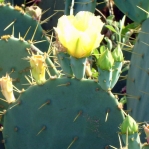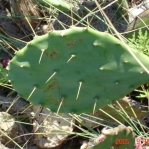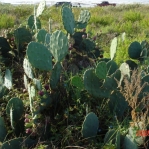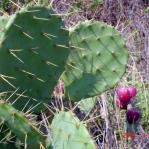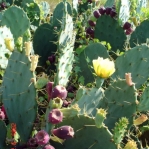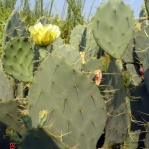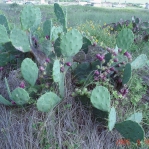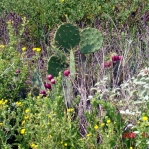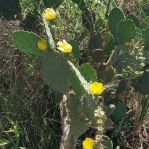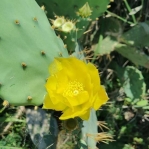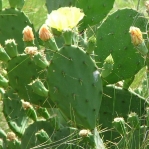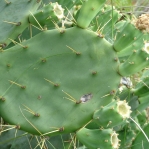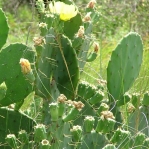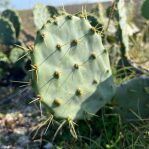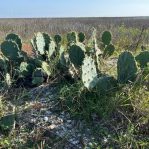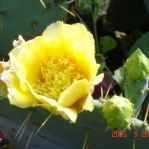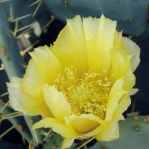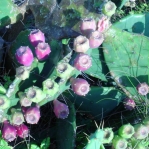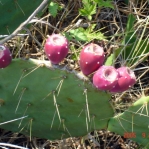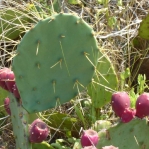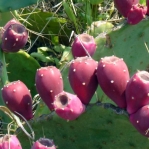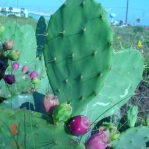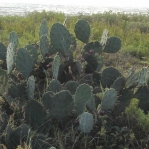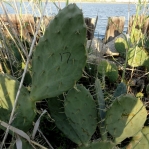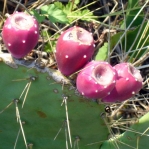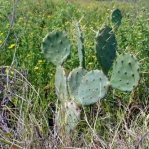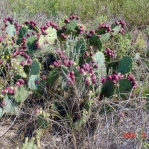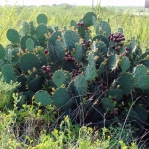
Griffiths, Annual Report of the Missouri Botanical Garden 22: 25, 1911
Holotype; Isotype; Isotype; Isotype; Isotype; Isotype; Herbarium; Drawing (seed)
O. bentonii is different from O. anahuacensis, but they are both beach prickly pears.
O. bentonii is different from O. stricta, but they are both beach prickly pears.
Original Citation
What is Opuntia bentonii?
Opuntia bentonii is a beach prickly pear cactus that resembles small or juvenile O. lindheimeri plants at first glance, but there are sustained differences between the two opuntias.
Details
O. bentonii is an open, erect prickly pear. The plants are generally under 50 cm tall. Mature O. bentonii cladodes are about 16 cm wide by 27 cm long and obovate (sometimes oval, elliptical, or subcircular). There may be 1-3(5) spines in upper areoles, yellow and translucent. Spines may be erect or recurved and up to 2.5 cm long but are often shorter. Sometimes spines are limited to the edge of the pads. The glochids may be at the top of the areole or scattered throughout. Veins are visible between areoles, and the areoles are raised-appearing because the pads are thinnish. The recurved leaves are about 5 mm long.
Flowers are large, up to 9-10 cm in diameter. The style is greenish-white and the stigma is yellowish-green or yellow (not green). Fruit is obovate-pyriform and the umbilicus is flattish–slightly raised or slightly depressed.
Ploidy is unknown.
Other Notes
O. bentonii prickly pears are distinct from O. lindheimeri in several ways. Whereas the former Opuntia is typically 50 cm tall or less and remains so in cultivation, O. lindheimeri can become a large plant (1-1.5 m tall and broad). The stigmas of O. bentonii are yellow or yellow-green in contrast to the decidedly green stigmas of O. lindheimeri. The seeds of O. bentonii are larger than those of O. lindheimeri (about 40% larger in diameter).
O. bentonii often grows with O. anahuacensis, but the two plants, while both low and with yellow spines, are quite different. O. anahuacensis often has fewer spines and tends to grow semi-horizontally. O. anahuacensis is an Opuntia that can form large and tangled thickets, whereas O. bentonii prickly pear plants stand upright (not horizontally ascending) even though there may be multiple plants growing together. The oval or obovate pads of O. anahuacensis may have a short neck, which is not found in O. bentonii. The areoles of O. bentonii are often raised, giving pads a dimpled look.
We have observed O. bentonii on Galveston Island, Bolivar Peninsula, and Sea Rim State Park near Port Arthur, Texas. This Opuntia is also reported from southwest Louisiana. Perhaps this prickly pear grows on the Gulf Coast in the many secluded areas of southeast Texas. We have not found this prickly pear away from the immediate coast.
O. bentonii has bright yellow flowers and does not get excessively tall. It is a good garden plant in USDA climate zone 9 but its ultimate cold tolerance is unknown. O. bentonii has some features in common with O. tunoidea of the South Carolina coast. If the two taxa are the same, the name with precedence is O. tunoidea. More study is needed.

